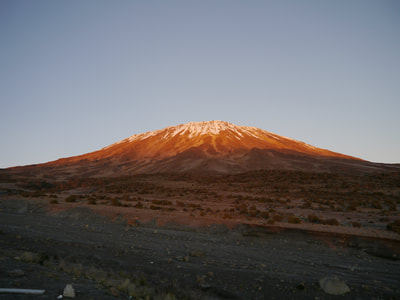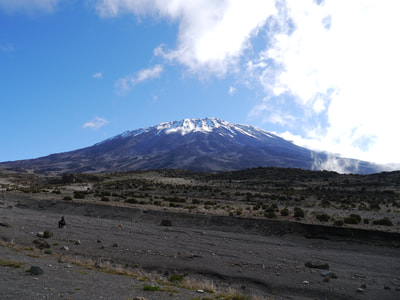|
4/3/2018 0 Comments project: kili 2018STEP 1. making a decision
First of all, you need to ask yourself a few questions before you decide on climbing Mount Kilimanjaro:
STEP 2. choosing a route
Depending on what's more important to you e.g. if you hate camping, the 'Coca-Cola' route (Marangu) is the most touristy one of them all with cabin accommodation. Ultimate Kilimanjaro highlights the various routes with the pros and cons of each of these:
We have decided to go for the less busy but longer Rongai route. Eek. STEP 3. SHOPPING list
STEP 4. training
Apparently just being 'relatively fit' isn't good enough for climbing Kilimanjaro. The success rate is around 65% according to climbkilimanjaroguide.com in terms of getting to the 'summit', depending on which route you take. At 5,895m height, most of the advice I have read on various blogs suggest that the trick is in walking slowly, acclimatising, practicing with long walks for 2-3 months before the trek.
I'm aiming to train three times a week, for at least one hour per session, at a minimum (compared to my usual 30 minute bursts). It is recommended that you do day hikes for 4 - 6 hours, with moderate elevation changes while carrying a 10kg pack. Here's a useful blog with tips on how to train: http://www.hikingdude.com/hiking-training.php Your longest and hardest workouts should be performed two to four weeks before your departure (the last two weeks, you should taper off your training and in the final days, rest so that your body has time to recover before your actual climb). In addition to walking/hiking, you can also supplement your training with exercises such as running or cycling, which will increase your aerobic capacity.95 m5,895 m5,895 STEP 5. climb a smaller mountain
7 weeks to go for the big climb, so we decided to test drive a 'baby' mountain: Mount Snowdon in Wales (1085m above sea level). It was probably made to be a bigger deal in my head than was necessary. The day before our trek, the lovely owners of our guesthouse (Min-y-don) in Llanfechain (pronounced: Cl-an....), told us that there were twelve casualties on the mountain a day ago. Although, one was a lady who wore heels... part of me would like to meet her.
Ok, so I did the second easiest, quickest and shortest trek up to the top (Well, almost. We didn't make it to the top only because the guards didn't let us... and we were tired). The route is called the 'Pyg track', and it's quite achievable, with the right boots and clothing... and weather, starting from Pen-y-Pass. Note: your parking skills will be tested (it gets busy and packed). Apart from the gorgeous dark green 'tarns' (glacial lakes), the snow on the top, the criss-crossing routes and craters made this day trek totally worth it.
STEP 6. fundraise for a good cause
We are more fortunate than many in the world. We complain about the weather, if our coffee wasn't brewed properly, if there are too many people on our train to work. All of these are legitimate complaints, by the way, but what we can also do, is occasionally think of and give to those who don't even have what we have: freedom (of speech), choice, food, (clean) water, health, a roof, clothes and shoes, respect, education and more.
As we climb to the top of Africa, we decided to raise money for FGM (Female Genital Mutilation), which is more common in Africa as well as Asia and the Middle East. UNICEF estimated in 2017 that 200 million women living today in 30 countries have undergone the procedures. FORWARD UK is an organisation that operates in the UK, Europe and Africa to safeguard girls at risk of FGM and support women through community engagement, advocacy and strategic partnerships. Their 2016/17 annual report and income:expense split can be found here. We raised almost £800 in 4 days and it shows how strongly people feel against this from colleagues at my workplace to friends of friends. It has been humbling. So if you decide to climb, it's worth doing something that gives something to those who need some help. Obviously, do some research and look at any charity company's annual reports and balance sheets to see how much of the income from donations actually goes to charity... (I was born a cynic!). step 7: go for a really long trek
4 weeks before Kilimanjaro and warm weather has finally decided to come to the UK, so a couple of us decided to venture out to the British coastline on a fine Saturday morning from London Victoria to Seaford in a very noisy train carriage thanks to a strange mix of a dozen young men with a variety of hair do's.
A short walk from Seaford station, we started to see the white bumpy cliffs that we saw earlier from our Google search. We thought we were on the 'blue' trail that was meant to go through a forest, but ended up on the 'yellow' one. The point is we walked up and down nine hilly cliffs towards Eastbourne, and the view from the edge of the sea and cliffside got better after each hill. Distance covered: 25km Time: 7 hours Nearest pub: 5 miles from Eastbourne I'm not quite sure why I had never ventured out here before... it's incredibly peaceful, beautiful and has some very strange birds, for those who like bird-watching. One of them made me laugh, it looked like a giant crow and it was skipping. We called it 'Skippy'. 5 miles before Eastbourne, we found a pub called 'The Beachy Head' that has outdoor seating and great dough sticks... and triple-cooked fries. Would recommend visiting, the food, service and ambience was just what we needed as a well-deserved treat after 20km. STEP 8: DON'T panic
This may sound contradictory to what many would say. You should most certainly read a few blogs from those who have climbed Mount Kilimanjaro, write down what's important (packing, diet, exercise, pacing yourself, the right clothing and equipment, medications, insurance for over 5800m altitude, luggage weight limits, portable toilets, tipping porters) and then build up on your positive attitude and ignore everything else.
I'm sure (most) people mean well when they share their personal experiences or some conclusions from someone they know, but in my opinion, there are no rules. As mentioned in my blog post 'Over the Hill', young or old, physically fit or not, some have climbed it in two days, while others walk for six days and don't make it to the top. No. Rules. Just work on your positive spirit, prepare as best as possible, be practical and sensible and go for it, without fear of 'failing' (not making it to the top) and without panicking yourselves. My friend kindly did some research for us and found the following blogs which cover plenty of information to give you the gist of what to expect. Feel free to read some or all of them, but do remember that everyone has unique experiences, as with everything else in life. Packing: https://www.climbmountkilimanjaro.com/practical-information/what-to-take/clothes Outside the ordinary advice: https://www.travelfearlesslyblog.com/tanzania/things-no-one-tells-you-about-climbing-kilimanjaro Diet: https://emilyrosecrocker.wordpress.com/2018/03/07/you-climbed-mt-kilimanjaro-was-it-hard Photos (for inspiration): https://thelongerroute.wordpress.com/2017/11/12/a-journey-to-the-roof-of-africa-mt-kilimanjaro step 9: zanzibar
Don't forget to book Zanzibar!
After all, you need to treat yourself for going through all the days of looking (and smelling) rough... just Google search Zanzibar and every single photo looks like the one above... turquoise green, clear watered haven. Approximately GBP 100 flight from Moshi in Tanzania (usually using Precision Air), after a night of resting in Moshi after the trek, you could fly out to Zanzibar - an island off the coast of Tanzania, part of the same country (so no extra visa required). Top 10 recommendations from the internet: 1. Zanzibar City - Old Fort, Mosques, Stone Town 2. Snorkeling 3. Swimming with turtles 4. Swimming with dolphins 5. Kitesurfing & lessons 6. Safari & Cheetah's rock 7. Visiting the Masaai 8. Sunbathing (we are staying at Nungwi beach because we want to try all the water sports, but we should visit Nakupenda beach which looks unreal on Tripadvisor) 9. Mtoni Palace Ruins (and live music) 10. Party time! Traveldudes.org gives a comprehensive list of all the places in Zanzibar City. STEP 10: MONEY
This is no cheap trip. So far, we have budgeted for:
GBP 250 - 300 for tipping the porters GBP 700 for flights (we're flying with Kenya Airways via Nairobi, Kenya) GBP 300 for hotels GBP 500 spending money in Zanzibar GBP 1800 for six days organised trek for Kilimanjaro TOTAL: GBP 3,550 Also, the Airport is 10 minutes away from Stone Town where you can get a couple of ATMs. USD is widely accepted by most places, but the local currency is Tanzanian Shilling (Tsh). ...as for what really happened?
After four days of walking and breathing slowly, monitoring our heart beats, using our walking poles once in a while, sipping water and electrolytes (Diarolyte for extra hydration) using our hydration bladders, constantly putting on and taking off our windproof rain jackets, the four of us and 13 porters and 3 guides made it to KIBO HUT i.e. the base camp at 4700m above sea level from where the night trek to the summit on Day 5 starts.
We were fed four (freshly cooked) meals a day with plenty of carbs and protein, thanks to our tour company Routes and Boots. We ate to our hearts' content every single day, which was amazing in a way. On 'summit night' we wore five layers on top, covered our heads and faces, wore these things called 'gaters' for the snow on top of the mountain and headed off with our head lamps... (a must) "pole pole" (meaning: slowly slowly). 1km up the slopes on the summit night felt like 10km (to me). Sadly, I had to turn back to the base camp as I couldn't breathe and had to sleep in the freezing cold tent in all my layers. In the words of one of my friends: it felt like prison. But despite the cold nights and having to go to the toilet at 4 a.m., the night sky lit by the moonlight and hundreds of stars, waking up to being above the clouds and bright sunlight (you need a lot of sunscreen to avoid getting sun burn) is totally worth it. Even better, due to the cold weather, there were no insects (hurrah!). FIRST-HAND TIPS: - A hot water bottle will be your best friend at night - You need to use walking poles, especially on the last day of walking downhill - Wear knee braces on the last day (Day 6) or they will hurt... a lot (carry Ibuprofen anyway) - You need a balaclava, no matter how horrendous you may look wearing one (a friend called me a 'blue worm') - Contact lenses can crack at the top of the mountain (temperatures can go down to -15 degrees celsius) - Your shins and the back of your shoulders will get burnt unless you wear sunscreen - Carry baby wipes and antibacterial at all times - A Go PRO in a waterproof case (or cheaper equivalents) will be useful if it rains or in snow (and is useful in Zanzibar) - You'll probably wear the same clothes for most of the trek... and you'll be fine! I wore normal gym clothes and a rain jacket for all 6 days - A sip of vodka at night is okay... (it felt amazing in the freezing cold at night). Overall, it was a once in a lifetime experience. What I learnt from the whole experience is that it's about the journey as well as the destination that makes it unforgettable. Not to forget, having gone with three of my best friends was the best decision ever. Favourite memory: waking up above the clouds.
0 Comments
|
Home |
Categories |
|








 RSS Feed
RSS Feed